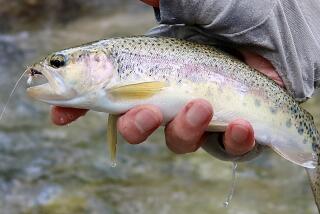FOR MEMBERS ONLY : From Their Base in the Unlikely Setting of a Valley Tackle Shop, a Group of Self-Proclaimed Purists Work Together to Further Cause of Fly Fishing
- Share via
A fly fishing club based in the San Fernando Valley? This must be a joke. Going to such lengths to stalk wily trout in the Valley?
And when you learn that the headquarters of the Sierra Pacific Flyfishers is in a Van Nuys fishing tackle store that sits in one of those really rustic, pristine, oh-so-rare mini-malls--Oh, like, gag me with a marabou streamer fly--the suspicion becomes even stronger that this must be a club full of anglers whose idea of a once-in-a-lifetime fishing adventure is rigging up the rod and reel and snagging old car batteries out of the Los Angeles River during a flood.
You imagine that this club is, at best, a cleverly devised tax shelter with roughly a dozen “members” who no one seems to be able to identify or locate right at the moment.
So what a surprise when you discover that the Sierra Pacific Flyfishers is a thriving organization with more than 500 members, active fly-fishing purists who practice stringent conservation measures, carefully craft their own tiny flies from hair and feathers and often go to sleep at night not with thoughts of blowing up the Ventura Freeway--as do most Valley residents--but of serene meadows and sparkling rivers and streams that are bursting with brilliantly colored rainbow and brown trout.
“It may seem strange,” said Ben Mintz, 56, who has been a member of the club since its beginning in 1972. “But in an environment like this, you need a club like this. It gives you a place to go to talk about fly fishing with other fly fishermen. It’s not easy to actually go fly fishing when you live here, so the next best thing is talking about it.”
There are a few areas within an hour or two of the Valley where fly fishermen can cast for trout with some chance of success. Piru Creek as it flows out of Lake Piru in the Angeles National Forest is one such spot. The West Fork of the San Gabriel River is another. But most club members choose instead to save their money and vacation time and head for the meccas of fly fishing in the West for once-a-year outings at places such as Hot Creek in the Sierra, the Yellowstone River in Montana, the North Platte in Wyoming and dozens of other rivers in Colorado and Idaho.
The group is headquartered in The Fishermen’s Spot in Van Nuys, a tackle shop that carries vast amounts of fly fishing equipment but also serves the general angling population. Business is business, but if some of the club members had a vote in the way owners Steve and Jeff Ellis run the store--and they don’t--the tackle designed for what they see as lesser forms of fishing would be loaded onto a truck and taken to a recycling plant. At the top of this list, according to Mintz, is the rock cod fisherman, the angler who dredges that very heavy and very ugly fish from the bottom of the sea, sometimes with an electric reel to ease the burden, with only dinner in mind.
“I wrote the club’s newsletter for the first three years,” said Mintz, who lives in North Hollywood and works in advertising and public relations. “One section had jokes. So I’d just take old Polish jokes and turn them into rock cod fishermen jokes. They were a riot.”
OK, Ben, so just how many rock cod fishermen does it take to make popcorn?
Eight. One to hold the pan still and seven to shake the stove.
Mintz does very little to dispel the notion that fly fishermen tend to see themselves as the only true anglers, that any other means of taking a fish is akin to dropping a stick of dynamite into a creek and netting the carcasses as they float to the surface.
“It’s true that fly fishermen tend to look down on other fishermen,” Mintz said. “But that’s just human nature. A concert violinist tends to look down on a guy banging a trash-can lid with a stick. A guy driving a Porsche tends to look down on a guy driving a Hyundai.”
Among themselves, however, fly fishermen tend to have few secrets.
“All the time on a stream you see guys exchanging ideas about the trout, giving each other flies that are catching fish at the moment,” Mintz said. “We are always willing to help out anyone who wants to catch a fish on a fly.”
Which is, according to Steve Ellis, a major cause of the Sierra Pacific Flyfishers.
“What’s nice about our club today is that it has many women and children who are members,” he said. “That’s what we want to encourage. Fly fishing is teaching people about ecology and conservation and the sheer enjoyment of the sport. And the joy of just being outdoors in pristine areas.”
The club has contributed thousands of dollars and many, many thousands of hours of back-breaking labor in an effort to salvage what little, if any, natural beauty remains in the area. Last month club members collected and hauled away 400 trash bags filled with broken glass, beer cans, diapers, rusted auto parts and other junk from Piru Creek north of Simi Valley. There are trout in Piru Creek, and Sierra Pacific members found something a bit unseemly about dragging a sparkling rainbow trout from the creek and onto the radiator of an old Buick.
Once a month the club holds a dinner meeting and brings in a noted fly angler to speak and, usually, narrate his slide show. For a few hours each month they gather to forget their hectic lives of filing legal briefs, performing root canals or trying to teach today’s video-games-on-the-brain schoolchildren the difference between the Wright Brothers and the Super Mario Brothers. They gather and they talk fish.
“I was the club’s 14th member when it began 17 years ago,” said Bob Ketchum, a retired stone mason. “No. 1, we all use it to gain fishing buddies. There’s a real shortage of those today. We learn places to go from one another and which flies to use. And those of us who have done it for a long time get to teach it to some of the younger people. That’s why I like it.
“Oh, and it’s also nice because you can sit around and tell lies to each other and no one minds.”
Ketchum, of San Fernando, has fly fished for 25 years, getting his introduction from “an old guy in Colorado” during a vacation.
“I loved it so much, I just went crazy,” Ketchum said.
This summer, for the sixth consecutive year, Ketchum and his wife will head for Colorado, Montana and Idaho, searching out the stream of their dreams on a fishing adventure that often lasts, “until the snow flies” in the Rocky Mountains.
Not many rock cod fishermen pursue their sport with that type of zeal.
“It’s just not like any other kind of fishing,” Ketchum said. “It’s nothing like fishing with bait where you just throw it out there and sit down and hope. Fly fishing is active participation. You don’t sit down. You are constantly trying to figure out the right fly in the right place at the right time of the day, trying to imitate a trout’s natural food. It’s frustrating sometimes, but when you find the right fly, you catch trout one right after the other.”
And that, for most people, would lead to this obvious question: “Who brought the lemon wedges?”
But, alas, devoted fly anglers seldom eat a fish.
“In the last three years I imagine I’ve caught 300 trout,” the aptly named Ketchum said. “But I haven’t eaten a single one of them. I haven’t killed a trout in so long I can’t remember the last time.”
It is a sport that can overwhelm a person.
George Chapman of Woodlands Hills, a retired U.S. Navy officer, fondly recalls the days when he and other government officials would leave their desks at the Pentagon and fly fish the Potomac River where it flows through Washington.
“There were a lot of us in the Pentagon during those days who fly fished,” said Chapman, who is also a skilled fly-tier.
The obsession can often, as even the dedicated club members admit, border on lunacy.
Ketchum and his wife found themselves in Yellowstone National Park last summer, searching for the perfect pool in the famed Madison River. And so they fished, day after day, hour after hour, only remotely cognizant of the fact that the great fires of Yellowstone--infernos that consumed hundreds of thousands of acres and sent smoke and ash billowing a half-mile into the sky and landing a thousand miles away--roared all around them.
“I made a new fly there one night and the next day, my wife caught 50 trout in about four hours,” Ketchum said. “There were firefighters all around us, resting by the river, and they’d stand up and clap and holler every time she hooked one.
“It was terrible smoke and fire, frightening things to see. But it didn’t hurt the fishing at all.”
And for some club members, it isn’t even the fishing that consumes them.
“For me, it’s something about the moving water of a stream,” said Jessie French, an accomplished artist who has had four one-person exhibits of her paintings and wood sculpture. “I love hunting the stream, following it through the woods or field. I love a familiar stream and I love a new, strange stream. It’s all the water . . . the intricacies of the flow.
“Sometimes I have dreams about the streams and the flowing water, water with fish in it. Sometimes they are real trout that I dream of and sometimes they are magical trout.”
Bring up the subject of magical rock cod with a grizzled old deep-sea fisherman and, after you climb back onto the dock in your soaking clothes, you’ll realize that fly anglers are indeed a different breed.
More to Read
Sign up for The Wild
We’ll help you find the best places to hike, bike and run, as well as the perfect silent spots for meditation and yoga.
You may occasionally receive promotional content from the Los Angeles Times.






